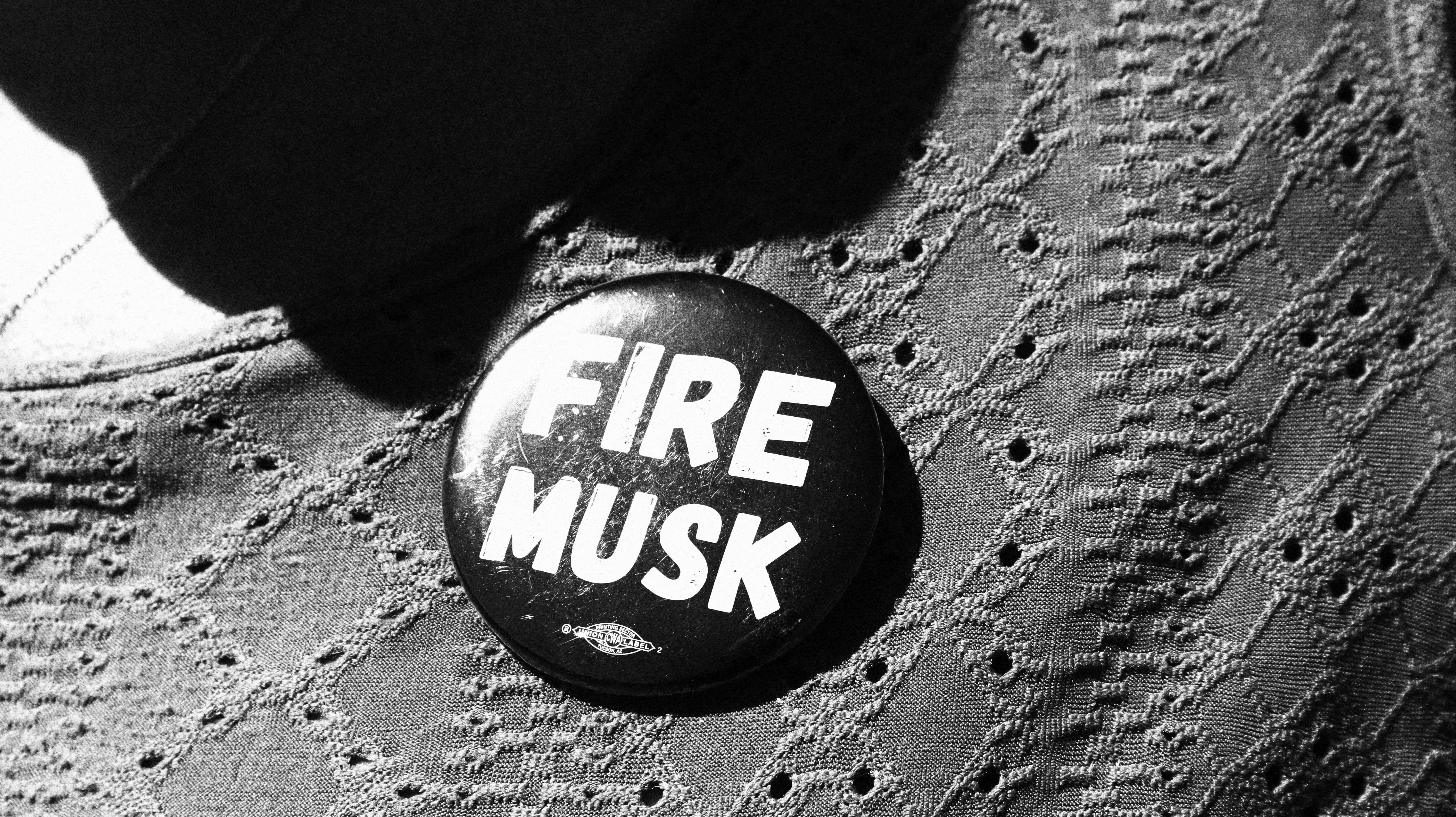Ed Martin Is Trampling the Rule of Law. And He Won’t Shut Up About It.
When Elon Musk ordered a government-wide email blast directing federal employees to list their recent accomplishments, most senior officials paused to consider their options. In the Justice Department, US attorneys around the country discussed the matter over an email list they share, with many deciding to seek more guidance before instructing career prosecutors on how to respond. One questioned whether the email was even real.
But Ed Martin, an acolyte of President Donald Trump named interim US attorney for the District of Columbia, charged ahead. “It’s legit and we’ve already replied,” he told his fellow US attorneys. “Great leadership.”
Just 33 minutes after the Office of Personnel Management directive hit inboxes, Martin urged lawyers under him to comply, though he suggested they respond carefully. “DOGE and Elon are doing great work!” Martin wrote in one of his frequent communiques to hundreds of assistant US attorneys and support staff. “We are happy to be participate.”
“We are happy to be participate.”
For Martin—a right-wing activist and serial political candidate who has enthusiastically defended January 6 rioters—this was just one more typographically challenged missive in a campaign to turn a powerful legal office into a partisan weapon. Since taking on the gig in January, he’s compensated for his lack of prosecutorial experience by loudly proclaiming his desire to help Trump and Musk use the DOJ to punish their foes. Trump quickly returned the favor, nominating him to hold the post indefinitely.
Martin, who did not respond to questions from Mother Jones, has announced investigations into his own staff for their role in January 6 cases and has volunteered to support Attorney General Pam Bondi’s Orwellian “Weaponization Working Group,” which purports to take aim at abuses of the justice system during the Biden administration. Martin has threatened former special counsel Jack Smith and Senate Minority Leader Chuck Schumer and has used X to indicate plans to investigate administration critics. He has even tried to leverage a dubious criminal probe to seize climate grant money awarded by the Biden administration.
The US Attorney in DC is investigating Georgetown Law School, demanding that "if DEI is found in your courses or teaching in anyway [sic]," the law school should "move swiftly to remove it"
Federal prosecutors don't control classrooms. pic.twitter.com/UCJhSe4uMp
— Adam Steinbaugh (@adamsteinbaugh) March 6, 2025
As he posts his way to prominence, Martin has bombarded his staff with chatty emails recounting his daily activities, then repeatedly berated them after those emails leaked. In a new administration defined by a mixture of malevolence and ineptitude, Martin has emerged as an avatar: a typo-spewing henchman of the moment, eager to help Trump transform the Justice Department into a political tool—and unable to shut up about it.
Eagle Ed
Martin, whom associates call outwardly affable, presents as a guy pleased and a bit surprised by his elevation.
“He has a little bit of buffoonery and a ‘Mr. Smith comes to Washington’ vibe,” said one person who has worked in the DC US attorney’s office.
His emails and other communications tend to read like daily journal entries. “Life is very different for me and my family these days,” Martin wrote in a February 4 Substack post. “I am up earlier and into the office in downtown DC. Home late. Pretty tired by then.”
“There is so much to tell you,” he added. “One aspect: my new office is large.”
If Martin is pinching himself at his new position, he has reason. While US attorneys are often experienced prosecutors or rising political prospects, Martin, 54, is more of a journeyman. He spent much of the past two decades as a conservative activist in Missouri, running a series of political organizations—a sort of far-right change agent who sometimes leaves behind litigation and enemies.
As chief of staff for Missouri Gov. Matt Blunt in 2007, Martin fired a state attorney, Scott Eckersley, who had warned against deleting emails that state law required be retained. In a lawsuit, Eckersley alleged that Martin and other officials had falsely accused him of “accessing group sex websites on his state computer” and had defamed him to the media. The state attorney general’s office ultimately agreed to pay Eckersley a $500,000 settlement in the matter.
Martin ran for Congress in 2010; he started and ended Senate and House campaigns in 2012, before committing to the state attorney general race that year. None of his campaigns were successful.
After a stint running Missouri’s GOP and heading several conservative nonprofits, Martin landed in 2015 as president of the Eagle Forum, an organization founded by conservative hero Phyllis Schlafly, then 90 years old. Within a year, Martin had been fired by the group’s board and accused by Schlafly’s daughter, Anne Schlafly Cori, of manipulating the aging icon to commandeer her organizations and legacy. In 2016, Cori and other group members sued Martin for alleged acts that included impersonating Schlafly in Facebook posts and other correspondence. “During Martin’s brief tenure, the Eagle Forum…has experienced unprecedented chaos,” the plaintiffs asserted in their complaint. Martin denied those claims.
In March 2016, with Martin at her side, Schlafly endorsed Trump. She died September 5, 2016. Her name appeared posthumously alongside Martin’s as an author of the book The Conservative Case for Trump, published the next day.
A year later, Roy Moore, the former Alabama Supreme Court chief justice then running for Senate, claimed Schlafly among his endorsers. Moore’s webpage, Roll Call reported, said: “Phyllis Schlafly, Late President, Eagle Forum; inference of Ed Martin.”
Martin by then had launched a new group, Phyllis Schlafly’s American Eagles. And he retained control of another Schlafly-founded nonprofit, the Eagle Forum Education and Legal Defense Fund. Tax filings by the latter group show Martin’s salary as president, which fluctuated, peaked at just over $204,000 in 2020. He’d received more than $1.4 million in total from the group as of 2023. He still uses the X handle @EagleEdMartin.
Martin netted more than $322,000 from yet another former Schlafly nonprofit, America’s Future, while serving as its president beginning in 2016. In 2021, Martin’s final year leading that group, he received more than $83,000 for the job, which, according to tax filings, took him eight hours per week. That year, the group appointed Michael Flynn, Trump’s former national security adviser and a prominent far-right conspiracy theorist, as its board chair. America’s Future also hired Flynn’s brother Joe and sister Mary to top jobs. Within a few years of Martin’s departure, America’s Future was paying hundreds of thousands of dollars to members of the Flynn family. Asked about this, Joe Flynn, a sometime-spokesperson for the family, texted: “Fuck off quote me.”
Stop the Steal
Martin moved to Virginia in 2017 and spent much of the first Trump administration as a far-right pundit. He lost a gig as a CNN contributor after complaining about appearing on the network alongside “Black racists.” He ran a feeble 2019 campaign for the Board of Supervisors in Fairfax County, Virginia. He also designed a coloring book based on Trump’s 2017 “covfefe” typo tweet. In it, aspiring artists can color in outlined images of Kanye West and Candace Owens under a West tweet boasting that he had a signed MAGA hat, or they can complete a connect-the-dots puzzle of a MAGA hat on a page advertising a free downloadable song sharing a “#CovfefeIsLove” message.
Wondering what that page is on  #TheMovement? It's a page from Can't Trump This Covfefe: Top Trump Tweets – The MODERN DAY PRESIDENTIAL Coloring and Activity Book for All Ages (but especially adults)! https://t.co/3hoC7nzEsL pic.twitter.com/4aB5J1WzSc
#TheMovement? It's a page from Can't Trump This Covfefe: Top Trump Tweets – The MODERN DAY PRESIDENTIAL Coloring and Activity Book for All Ages (but especially adults)! https://t.co/3hoC7nzEsL pic.twitter.com/4aB5J1WzSc
— Ed Martin (@EagleEdMartin) June 5, 2018
Martin gained focus following the 2020 election, organizing pro-Trump protests alongside Ali Alexander, the “Stop the Steal” activist who claimed he “came up with the idea” to pressure Congress on January 6 to not certify Biden’s victory.
Martin “was kind of like a mentor,” Alexander said in a December 2021 deposition conducted by the House January 6 committee. According to Alexander, the two men “prayed together every morning.”
In depositions, other January 6 rally organizers expressed various concerns about Alexander, who raised hundreds of thousands of dollars without setting up a nonprofit group or accounting for the funds. But Martin offered his own nonprofit as a place for Alexander to park cash, Alexander told the committee. Martin’s group acted “as a sponsor for collecting Stop the Steal funds” for the rally, Alexander testified. Alexander did not respond to inquiries from Mother Jones.
In late 2020, Martin was in regular contact with Vincent Haley, a White House aide, according to previously unreported text messages released by the January 6 committee. Shortly after the election, Martin urged Haley to “push” a pardon for Michael Flynn, who had pleaded guilty in 2017 to lying to the FBI but was never imprisoned. The Trump DOJ already had dropped the case against Flynn, but Martin suggested that the former general would be more willing to join Stop the Steal rallies once pardoned. “He’d come to dc for the rally/March,” Martin texted Haley on November 10. “We need that guy loosed.”
“I have recommended it,” Haley responded. It is not clear whether Martin’s pressure had any impact, and Haley didn’t respond to Mother Jones’ questions. But Trump pardoned Flynn on November 26, 2020. Flynn then spoke at DC rallies on December 12 and January 5.
“They know they’re going to jail.”
Martin also spoke at those rallies. And he was outside the Capitol on January 6, 2021, as rioters attacked police. But Martin, who was not charged with a crime, saw no evil. “Rowdy crowd but nothing out of hand,” Martin tweeted at 2:53 p.m. that day. “Ignore the #FakeNews.” In a video he posted the next day, Martin repeated false claims that the attack had been orchestrated by left-wing infiltrators. “Now we know that it was antifa,” he said. “It was plants.”
Martin’s efforts drew a subpoena from the January 6 committee. He ignored it, failing to appear for a scheduled deposition. He went on to become a vocal advocate for attackers facing legal charges and represented several people charged with taking part in the riot.
Martin was no ordinary defense attorney. He suggested that the defendants should receive “reparations” and pushed a bizarre and unsubstantiated conspiracy theory that “January 6 was staged by Mr. Coffee,” a supposedly unidentified man seen drinking coffee near the gallows display constructed outside the Capitol that day. Martin pursued this theory vigorously, posting “missing person” flyers featuring grainy images of the man around Washington.
On the right-wing podcast circuit, he called for “accountability” for those who had investigated January 6. “One of the reasons I think that we should fear for this election,” he said last summer, “is because there’s hundreds of Democrats and some Republicans—Liz Cheney—that they know they’re going to jail.”
“A Great Failure of Our Office”
Martin began working as US attorney on Inauguration Day, the day Trump granted clemency to 1,600 January 6 defendants. The president’s vaguely worded declaration largely left implementation to the DOJ. Martin took on that task with alacrity.
When a judge barred Oath Keepers founder Stewart Rhodes, whose 18-year sentence Trump had commuted, from entering DC, Martin intervened, successfully arguing that the order was improper. Rhodes—who has since shown up on Capitol Hill—later told reporters that the judge “got slapped down by Ed Martin.”
As an interim US attorney, Martin can serve a maximum of 120 days, unless the Senate confirms him to fill the job permanently. He wasted no time in reshaping the office in his image, demoting key attorneys who’d worked on January 6 cases and initiating an internal investigation of prosecutors who charged defendants with violating a particularly harsh obstruction statute—18 USC 1512—that the Supreme Court later ruled did not apply to most of the rioters.
For Martin, the DOJ’s use of the that provision had long been an obsession. “Who ordered the 1512?” he asked on Charlie Kirk’s podcast in 2023. “If it was [Merrick] Garland, or [former Deputy Attorney General] Lisa Monaco, or Joe Biden, or Hunter…that guy or gal needs to end up in jail.”
In a January 27, 2025, email that began by lamenting the Washington Commanders’ playoff loss the day before, Martin asked DC prosecutors to hand over material relevant to his probe into this matter, which he dubbed the “1512 Project.”
“Obviously, the use [of the statute] was a great failure of our office,” he wrote to his staff, “and we need to get to the bottom of it.” The next day, he reminded employees to cough up information about their own activities. “Please be proactive – if you have nothing, tell the co-chairs,” he wrote. “Failure to do so strikes me as insubordinate.”
News of this investigation was quickly reported. “Wow, what a disappointment to have my email yesterday to you all was leaked almost immediately,” Martin wrote in another email. “Again, personally insulting and professionally unacceptable. I guess I have learned my lesson.”
Maybe not. A few days later, Martin was again chastising his staff after Reuters reported that he had put his name on a January 21 DOJ filing requesting that a judge dismiss charges against one of Martin’s personal January 6 clients, whom Trump had just pardoned. Martin, it emerged, had not withdrawn as the man’s attorney, putting him on both sides of the case, an ethical breach that drew a bar complaint. (In a February 5 filing, he told the judge that he had not actually represented that defendant since 2023 and asked to withdraw from the case.)
“I have said repeatedly over the past few days that we must protect our lawyers, staff, and all on our team from doxing, from attacks and from any threats,” he wrote in a February 5 email to his staff complaining about that “leak.” He urged them to join a training “to protect ourselves from unethical behavior.” This admonishment came a few paragraphs after Martin’s description of his visit to Frederick Douglass’ house in DC—“It’s a fascinating site and I encourage you to visit”—and a meeting with DC District Court Chief Judge James Boasberg and other judges: “It was an off the record conversation, but I can say it was an extraordinary one.”
“Noone Is Above the Law”
Martin has also made repeated public offers of DOJ assistance in combating the Trump administration’s enemies. Shortly after Wired reported the names of engineers working for Musk’s Department of Government Efficiency—prompting a flurry of social media attention and public complaints from the billionaire—Martin posted an image of a letter to Musk on X. In it, he typed, “Dear Elon,” which he then crossed out and replaced with a handwritten “Elon.”
“I ask that you utilize me and my staff to assist in protecting the DOGE work and DOGE workers,” Martin wrote. “Any threats, confrontations, or other actions in any way that impact their work may break numerous laws.” Five hours later, Martin posted that his office already had found that “certain individuals and/or groups have committed acts that appear to violate the law in targeting DOGE employees.”
Martin released a new letter February 7—which he clarified had been “sent only via X.” He again crossed out a typed “Elon” in favor of a handwritten “Elon.”
Follow up.
Sent only via X: to @elonmusk pic.twitter.com/FVO7pDFf3Q
— Ed Martin (@EagleEdMartin) February 7, 2025
“Thank you for the referral of individuals and networks who appear to be stealing government property and/or threatening government employees,” Martin wrote. “If people are discovered to have broken the law or even acted simply unethically, we will investigate them and we will chase them to the end of the Earth to hold them accountable.”
He added, misspelled and in bold: “Noone is above the law.”
Martin has since routinely used his X account to publicly suggest that the Trump DOJ might take action in response to allegations lobbed on social media. “Duly noted,” he wrote in response to a request from the Homeland Security Department X account that he look into an unsubstantiated DOGE claim that a “Biden transition team member” had rigged a contract. “We are on it.”
As large protests against DOGE began last month, Martin retweeted a post by Mike Cernovich, a commentator known for his role in boosting a false conspiracy theory related to Pizzagate back in 2016. Cernovich was now suggesting that Trump fans take advantage of Martin’s presence at the DOJ to “attend far left wing rallies, capture the reaction, and where appropriate, seek criminal prosecution.”
Martin in January personally wrote to Schumer, threatening legal action over a 2020 speech warning Supreme Court justices against curtailing abortion rights. “You have released the whirlwind and you will pay the price,” Schumer said at the time. The Democratic senator wasn’t threatening actual violence, but he expressed regret for his statement the day after he made it, saying he meant “there would be political consequences.” And his chief of staff appears to have explained that in a response to Martin’s query.
But Martin, in a February email, asserted that Schumer had ignored him, calling the snub “a personal disappointment and professionally unacceptable.” That’s nearly the same phrase Martin used to berate his staff for email leaks. He urged Schumer to “complete this inquiry before any action is taken. I remind you: no one is above the law.”
Days later, Martin forced the resignation of Denise Cheung, a 24-year DOJ veteran, after she declined to launch a criminal probe and freeze assets of an environmental group awarded a contract by the Biden administration. Martin then personally submitted a seizure warrant application, an extraordinary move for a US attorney. A magistrate judge rejected the request, finding the application lacked sufficient evidence of a crime, the Washington Post reported.
pic.twitter.com/utpmdIEmk7
— U.S. Attorney DC (@USAO_DC) February 24, 2025
The same week, Martin helped defend the administration from a lawsuit filed by the Associated Press, which had been barred from some White House events over the news organization’s refusal to adopt “Gulf of America” in its style guide. “As President Trumps’ [sic] lawyers, we are proud to fight to protect his leadership as our President,” he declared in a graphic posted on X by the US attorney’s office while a court hearing in the case was taking place. The AP, he complained, was refusing “to put America first.”
On February 17, Trump officially nominated Martin for the permanent US attorney job. His conduct so far could complicate his Senate confirmation. Even Sen. Josh Hawley, Martin’s fellow Missouri election denier, has declined to commit to backing him. But the same antics that leave some Republican lawmakers wary of Martin appear to make him exactly who the president wants.
Meanwhile, Martin is still firing off communiques. A few days after ousting Cheung, he sent his staff pictures from a meeting with Joe diGenova, a pro-Trump former DC US attorney who once claimed Fox News “is compromised when it comes to” George Soros. “These weeks have been a whirlwind,” Martin commented. “Meeting so many new people.”
In a March 15 Substack post, Martin again groused about his emails leaking. “Personally insulting and professionally unacceptable,” he wrote. “But regularly happening.” He added that he is “actively and carefully (quietly!) investigating. And when I find the leaks, you will find the accountability.”
The same day, Martin renewed his search for “Mr. Coffee,” posting a video he’d previously made suggesting “the real architects of January 6” were connected to the FBI. “Worth a look, no?” the interim US attorney wrote. “Who lied to us?”
Continue Reading…
 (@yashar)
(@yashar) 








